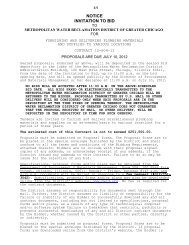Report - Metropolitan Water Reclamation District of Greater Chicago
Report - Metropolitan Water Reclamation District of Greater Chicago
Report - Metropolitan Water Reclamation District of Greater Chicago
You also want an ePaper? Increase the reach of your titles
YUMPU automatically turns print PDFs into web optimized ePapers that Google loves.
5. To provide technical support on green initiatives relevant to the <strong>District</strong>'s<br />
operations.<br />
Environmental Monitoring. In 2010, the Section conducted the following monitoring<br />
and reporting activities to comply with permits and regulations governing the biosolids<br />
management programs:<br />
Monitoring <strong>of</strong> Wells and Lysimeters at Biosolids Drying Facilities. This monitoring and<br />
quarterly reporting is conducted for six biosolids drying facilities according to permits issued by<br />
the IEP A. These facilities are the Calumet East, Calumet West, Lawndale Avenue, Harlem<br />
Avenue, Ridgeland Avenue, and Stony Island Avenue drying sites. In 2010, a total <strong>of</strong> 24<br />
quarterly monitoring reports were submitted to IEP A. The reports include results <strong>of</strong> sampling<br />
and analysis <strong>of</strong> groundwater and biosolids.<br />
Environmental Monitoring at Hanover Park Fischer Farm. All biosolids generated at<br />
the Hanover Park WRP are land applied at the Fischer Farm located on the grounds <strong>of</strong> the plant.<br />
Biosolids are temporarily held in lagoons then land applied by subsurface injection <strong>of</strong> the solids<br />
or supernatant according to the permit issued by the IEP A. The Section is responsible for<br />
providing technical support to the monitoring program and the quarterly monitoring reporting by<br />
the permit. In 2010, four monitoring reports were submitted to IEP A<br />
Biosolids Monitoring under Process to Further Reduce Pathogens Certification. The<br />
Section is responsible for maintaining the <strong>District</strong>'s site-specific certification <strong>of</strong> processes that<br />
further reduce pathogens for biosolids processing trains at the Stickney and Calumet WRPs, as<br />
awarded by the USEP A. In this certification, the <strong>District</strong>'s air-dried biosolids generated<br />
according to a codified operation is designated as Class A according pathogen standards under<br />
the USEP A Part 503 Rule. The monitoring program for this certification includes pathogen<br />
analysis <strong>of</strong>biosolids and semi-annual reporting to the USEPA. In 2010, two monitoring reports<br />
were submitted to the USEP A.<br />
Fulton County Land <strong>Reclamation</strong> Site. The Fulton County land reclamation site was<br />
used for land application <strong>of</strong> biosolids to reclaim strip-mined land from 1972 to 2004 under a<br />
permit issued by the IEP A. The site permit required monitoring <strong>of</strong> soil, crops, groundwater, and<br />
surface water. All environmental monitoring required by the permit was terminated in 2007 until<br />
such time that application <strong>of</strong> biosolids on the site resumes. Discretionary environmental<br />
monitoring on a limited number <strong>of</strong> fields and groundwater and surface water sites are collected<br />
every two years. In 2010, one annual report was submitted to the IEP A.<br />
Promotion <strong>of</strong> Biosolids Beneficial Reuse and Technical Support to Biosolids Users.<br />
The Section assists in the local marketing <strong>of</strong> biosolids and providing technical support to<br />
26
















